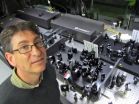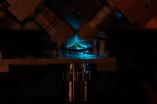(Press-News.org) Soy isoflavone tablets do not appear to be associated with a reduction in bone loss or menopausal symptoms in women within the first five years of menopause, according to a report in the August 8 issue of Archives of Internal Medicine, one of the JAMA/Archives journals.
The beginning stages of menopause are often accompanied by rapid bone loss, hot flashes, vaginal dryness and sleep disturbances among other symptoms, according to background information in the article. "Estrogen therapy with or without progesterone prevents most of these changes. However, as a result of the Women's Health Initiative findings suggesting that the overall risks outweigh the benefits, most menopausal women now decline estrogen therapy, increasingly seeking other alternatives," the authors write. "Soy-derived products have been proposed to provide comparable benefits to estrogens but without the risks."
Silvina Levis, M.D., of the Miami Veterans Affairs Healthcare System and Miller School of Medicine, University of Miami, and colleagues, conducted a randomized controlled trial from July 2004 to March 2009 to determine the effectiveness of soy isoflavone tablets in preventing bone loss and other menopausal symptoms. Study participants received a soy isoflavone dose equivalent to approximately two times the highest intake through food sources in a typical Asian diet to ensure they received an effective dose. Women 45 to 60 years of age, within five years of menopause and with a bone mineral density T score (bone density compared with what is normally expected in a healthy young adult of the same sex) of -2.0 or higher in the lumbar spine or total hip were eligible for the study.
A total of 248 women were eligible for the study; 126 were randomized to the group receiving placebo tablets and 122 were randomized to the soy isoflavone group, who received 200 mg of soy isoflavone tablets daily. During two years of follow-up, no significant differences were found between women in the soy isoflavone group and placebo group regarding changes in bone mineral density of the spine (-2 percent vs. -2.3 percent), the total hip (-1.2 percent vs. -1.4 percent) or the femoral neck (-2.2 percent vs. -2.1 percent), respectively.
Additionally, the number of menopausal symptoms was comparable between the two groups at baseline and the end of the study, except hot flashes. At the end of the study, 48.4 percent of women in the soy isoflavone group and 31.7 percent of women in the placebo group reported hot flashes. The authors also found that a higher number of women in the soy group reported constipation compared with women taking placebo (31.2 percent vs. 20.6 percent) but this was not statistically significant.
"Because of concerns regarding the risk of estrogens, a need exists for alternative interventions that could provide the beneficial effects of estrogens in bone and menopausal symptoms without the adverse effects on breast and cardiovascular health," the authors conclude. However, "we found that our population of women in the first five years of menopause, on average, had low rates of bone loss, and that 200 mg of soy isoflavone tablets taken once daily does not prevent bone loss or reduce bone turnover or menopausal symptoms."
(Arch Intern Med. 2011;171[15]:1363-1369. Available pre-embargo to the media at www.jamamedia.org.)
Editor's Note: This study was supported by a grant from the National Institute of Arthritis and Musculoskeletal and Skin Diseases, National Institutes of Health. Please see the article for additional information, including other authors, author contributions and affiliations, financial disclosures, funding and support, etc.
Commentary: Soy Isoflavones for Prevention of Menopausal Bone Loss and Vasomotor Symptoms
"Every woman who lives long enough will go through the menopause transition; approximately 80 percent will experience hot flashes and night sweats, and approximately 20 percent will experience sufficient discomfort to seek treatment," write Katherine M. Newton, Ph.D., of the Group Health Research Institute, Group Health Cooperative, Seattle, and Deborah Grady, M.D., M.P.H., of the University of California, San Francisco and San Francisco VA Medical Center.
"In this issue of the Archives, Levis et al report the results of the National Institutes of Health–funded Soy Phytoestrogens as Replacement Estrogens (SPARE) trial," the authors write. "The SPARE study was designed to overcome the limitations of many prior trials of soy products, including poor design, small sample size and short duration."
The authors do note that, "the main shortcoming of the study was that only 248 of an expected 306 participants were enrolled, and higher-than-expected dropout rates led to a final sample size substantially lower than that predicted." However, even with the smaller sample size, "given the virtually identical results in the two groups, it is difficult to imagine that the results would have differed substantially with additional participants or better retention," the authors write. "Overall it does not appear that soy supplementation will play an important role in osteoporosis prevention."
"To some extent, we are constrained because the mechanism of hot flashes and night sweats remains unknown," the authors conclude. "Perhaps efforts should be directed away from the hope of a one-size-fits-all therapy for menopausal symptoms toward using existing treatments to target the symptoms that disturb patients most."
###(Arch Intern Med. 2011;171[15]:1369-1370. Available pre-embargo to the media at www.jamamedia.org.)
Editor's Note: Please see the article for additional information, including author contributions and affiliations, financial disclosures, funding and support, etc.
To contact Silvina Levis, M.D., call Omar Montejo at 305-243-5654 or e-mail omontejo@miami.edu. To contact commentary co-author Deborah Grady, M.D., M.P.H., call Karin Rush-Monroe at 415-502-NEWS or e-mail karin.rush-monroe@ucsf.edu.
Soy tablets not associated with reduction in bone loss or menopausal symptoms in women
2011-08-09
ELSE PRESS RELEASES FROM THIS DATE:
Massachusetts health-care reform associated with increased demand for medical safety-net facilities
2011-08-09
Patient demand for care from safety-net providers (such as community health centers and public hospitals) in Massachusetts has increased, even though the number of patients with health insurance also increased following the state's passage of health care reform, according to a report in the August 8 issue of Archives of Internal Medicine, one of the JAMA/Archives journals. The article is part of the journal's Health Care Reform series.
According to background information in the article, a disproportionate share of patients who do not have health insurance obtain care ...
Newly discovered antibody recognizes many strains of flu virus
2011-08-09
Some vaccines are once-in-a-lifetime; others need a booster shot or two to maintain their potency. And then there's the flu vaccine, which only lasts a year. Strains of influenza virus change so much from year-to-year that new vaccines must be developed annually to target the strains of virus that are most likely to cause illness. But Howard Hughes Medical Institute (HHMI) scientists have now discovered a human antibody that recognizes many different flu strains. Understanding more about this antibody may help scientists design a longer-lasting vaccine against the influenza ...
Meteorites: Tool kits for creating life on Earth
2011-08-09
Washington, D.C.—Meteorites hold a record of the chemicals that existed in the early Solar System and that may have been a crucial source of the organic compounds that gave rise to life on Earth. Since the 1960s, scientists have been trying to find proof that nucleobases, the building blocks of our genetic material, came to Earth on meteorites. New research, published next week in the Proceedings of the National Academy of Sciences, indicates that certain nucleobases do reach the Earth from extraterrestrial sources, by way of certain meteorites, and in greater diversity ...
Biology, materials science get a boost from robust imaging tool
2011-08-09
EUGENE, Ore. -- (Aug. 8, 2011) -- Shape and alignment are everything. How nanometer-sized pieces fit together into a whole structure determines how well a living cell or an artificially fabricated device performs. A new method to help understand and predict such structure has arrived with the successful use a new imaging tool.
Coupling laser-driven, two-dimensional fluorescence imaging and high-performance computer modeling, a six-member team -- led by University of Oregon chemist Andrew H. Marcus and Harvard University chemist Alan Aspuru-Guzik -- solved the conformation ...
Guam researcher studies Mount Pinatubo ecosystem recovery
2011-08-09
University of Guam ecologist Thomas Marler recently mobilized efforts to characterize the vegetation that has recovered following the eruption of Mount Pinatubo, Philippines. "My interest was sparked by the paradox that this volcano's cataclysmic 1991 eruption was so powerful it changed global climate, yet after a full 15 years the biology of the recovering ecosystem had not been studied," said Marler.
The void of research motivated the Guam ecologist to spend a majority of 2006 conducting botanical surveys on the mountain. Marler then teamed up with University of Washington ...
Heavy metal -- in and around the lakes
2011-08-09
Heavy metal pollution of lakes has a seriously detrimental impact on people and ecosystems that rely on such bodies of water. According to a study published in the current issue of Interdisciplinary Environmental Review, researchers have focused on the physicochemical properties and toxicology of water from and around Thane City of Maharashtra.
Environmental chemist Pravin Singare of Bhavan's College, in Mumbai, and colleagues highlight the fact that fresh water bodies all over the world are becoming increasingly polluted day by day and that this represents a growing ...
Improved radical surgery techniques provide positive outcomes for bladder cancer patients
2011-08-09
Bladder cancer patients who have radical surgery at university hospitals can benefit from excellent local control of the disease, acceptable clinical outcomes and low death rates, according to research in the August issue of the urology journal BJUI.
Researchers studied 2,287 patients who had radical cystectomy surgery, where the bladder is removed, together with nearby tissue and organs as required. The surgery was performed at eight Canadian academic centres between 1998 and 2008.
The study found that there were three independent factors, apart from pathological ...
Live from the scene: Biochemistry in action
2011-08-09
Researchers can now watch molecules move in living cells, literally millisecond by millisecond, thanks to a new microscope developed by scientists at the European Molecular Biology Laboratory (EMBL) in Heidelberg, Germany. Published online today in Nature Biotechnology, the new technique provides insights into processes that were so far invisible.
By combining light-sheet microscopy and single molecule spectroscopy, the new microscope can record the fluorescence of every pixel within view, and take snapshots at intervals of less than one millisecond. With it, scientists ...
'Paranoia' about rivals alters insect mating behavior
2011-08-09
Scientists at the University of Liverpool have found that male fruitflies experience a type of 'paranoia' in the presence of another male, which doubles the length of time they mate with a female, despite the female of the species only ever mating with one male.
Females in many species of animal have multiple mates and males have evolved particular reproductive characteristics to ensure their sperm are successful when in competition with the sperm of other males. Adaptations include physical traits that result in increased sperm count, as well as behavioural alterations ...
Schoolchildren can also learn complex subject matters on their own
2011-08-09
Calculating the surface area of Gran Canaria is no easy task for a 14-year-old. It's not simply a question of learning the right formula. Students have to develop a strategy that enables them to put mathematical theory into practice – working out the information that is important and applying the right geometric models and tools. Realizing that the island has an almost circular shape and so its surface area can be approximated using the area of a circle is not as straightforward as it sounds. Are schoolchildren capable of developing these kinds of solutions themselves or ...


